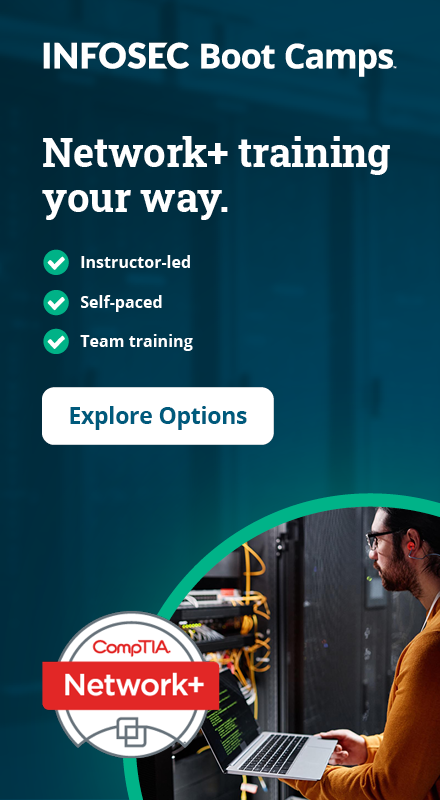Network+ domain #1: networking fundamentals [2022 update]
One of the most recognizable IT and information security networking certifications is Network+. As time goes on, new versions of certification exams are released, and Network+ releases the latest exam version, N10-008, in September of 2021. Some of the material covered in this latest exam version has changed and changes to Domain names. This article will detail Network+ Domain 1.0, entitled Networking Fundamentals. It will explore what the Network+ cert is, what has changed since the last Network+ exam version, and the objectives and sub-objectives this Domain covers. If you are looking for a great starter to your Network+ exam outline for Domain 1.0, look no further.

Earn your Network+ certification, guaranteed!
What is Network+?
Network+ is an IT and information security networking certification offered by CompTIA. This certification validates the skills and knowledge required to securely establish, maintain, and troubleshoot essential organization networks. This is one of the most popular networking certs on the market, with 500,000 cert holders worldwide.
What has changed since the last Network+ exam version?
There have been some changes since exam version N10-007 that you need to be aware of. Aside from Domain name changes and slight changes to exam material weights, there have been sub-objective changes, especially on the foundational networking tools and technologies used to create secure networks. Below is a comparison of N10-007 and N10-008 (and their respective weights of exam material covered):
Domain 1.0 has had a slight name change since the last exam version and is now Networking Fundamentals. It also covers a little more material, adding an extra 1% of exam material to what it covers. Without further ado, let’s dive into the material covered by Domain 1.0.
Domain 1.0: Networking Fundamentals
1.1 Compare and contrast the Open Systems Interconnection (OSI) model layers and encapsulation concepts
1. OSI Model
- Layer 1 – Physical
- Layer 2 – Data link
- Layer 3 – Network
- Layer 4 – Transport
- Layer 5 – Session
- Layer 6 – Presentation
- Layer 7 – Application
2. Data encapsulation and decapsulation within the OSI model context
- Ethernet header
- Internet Protocol (IP) header
- Transmission Control Protocol (TCP)/User Datagram Protocol (UDP) headers
- TCP flags
- Payload
- Maximum transmission unit (MTU)
1.2 Explain the characteristics of network topologies and network types
1. Types of network topologies
- Mesh
- Star/hub-and-spoke
- Bus
- Ring
- Hybrid
2. Network types and characteristics
- Peer-to-peer
- Client-server
- Local area network (LAN)
- Metropolitan area network (MAN)
- Wide area network (WAN)
- Personal area network (PAN)
- Campus area network (CAN)
- Storage area network (SAN)
- Software-defined wide area network (SDWAN)
- Multiprotocol label switching (MPLS)
- Multipoint generic routing encapsulation (mGRE)
3. Service-related entry point
- Demarcation point
- Smartjack
4. Virtual network concepts
- vSwitch
- Virtual network interface card (vNIC)
- Network function virtualization (NFV)
- Hypervisor
5. Provider links
- Satellite
- Digital subscriber line (DSL)
- Cable
- Leased line
- Metro-optical
1.3 Summarize the types of cables and connectors and explain which is the appropriate type for a solution
1. Copper
- Twisted pair
- Cat 5/5e
- Cat 6/6a
- Cat 7
- Cat 8
- Coaxial/R6
- Twinaxial
- Termination standards
- TIA/EIA-568A
- TIA/EIA-568B
2. Fiber
- Single-mode
- Multimode
3. Connector types
- Local connector (LC), Straight tip (ST), Subscriber connector (SC), Mechanical transfer (MT), registered jack (RJ)
- Angled physical contact (APC)
- Ultra-physical contact (UPC)
- RJ11
- RJ45
- F-type connector
- Transceivers/media converters
- Transceiver types
4. Cable management
- Patch panel/patch bay
- Fiber distribution panel
- Punchdown block
- 66
- 110
- Krone
- Bix
5. Ethernet standards
- Copper
- 10BASE-T
- 100BASE-TX
- 1000BASE-T
- 10GBASE-T
- 40GBASE-T
6. Fiber
- 100BASE-FX
- 100BASE-SX
- 1000BASE-SX
- 10GBASE-SR
- 10GBASE-LR
- Coarse wavelength division multiplexing (CWDM)
- Dense wavelength division multiplexing (DWDM)
- Bidirectional wavelength division multiplexing (WDM)
1.4 Given a scenario, configure a subnet and use appropriate IP addressing schemes
1. Public vs. private
- RFC1918
- Network address translation (NAT)
- Port Address translation (PAT)
2. IPv4 vs. IPv6
- Automatic Private IP
- Addressing (APIPA)
- Extended unique identifier (EUI-64)
- Multicast
- Unicast
- Anycast
- Broadcast
- Link local
- Loopback
- Default gateway
3. IPv4 subnetting
- Classless
- Classful
- A
- B
- C
- D
- E
- Classless Inter-Domain Routing (CIDR) notation
4. IPv6 concepts
- Tunneling
- Dual stack
- Shorthand notation
- Router advertisement
- Stateless address autoconfiguration (SLAAC)
1.5 Explain common port and protocols, their application, and encrypted alternatives
1. Protocols and their ports
- File Transfer Protocol (FTP): 20/21
- Secure Shell (SSH): 22
- Secure File Transfer Protocol (SFTP): 22
- Telnet: 23
- Simple Mail Transfer Protocol (SMTP): 25
- Domain Name System (DNS): 53
- Dynamic Host Configuration Protocol (DHCP): 67/68
- Trivial File Transfer Protocol (TFTP): 69
- Hypertext Transfer Protocol (HTTP): 80
- Post Office Protocol v3 (POP3): 110
- Network Time Protocol (NTP): 123
- Internet Message Access Protocol (IMAP): 143
- Simple Network Management Protocol (SNMP): 161/162
- Lightweight Directory Access Protocol (LDAP): 389
- Hypertext Transfer Protocol Secure (HTTPS) [Secure Sockets Layer (SSL)]: 443
- HTTPS [Transport Layer Security (TLS)]: 443
- Server Message Block (SMB): 445
- Syslog: 514
- SMTP TLS: 587
- Lightweight Directory Access Protocol (over SSL) (LDAPS): 636
- IMAP over SSL: 993
- POP3 over SSL: 995
- Structured Query Language (SQL) Server: 1433
- SQLnet: 1521
- MySQL: 3306
- Remote Desktop Protocol (RDP): 3389
- Session Initiation Protocol (SIP): 5060/5061
- IP protocol types
1.6 Explain the use and purpose of network services
1. DHCP
- Scope
- Exclusion ranges
- Reservation
- Dynamic assignment
- Static assignment
- Lease time
- Scope options
- Available leases
- DHCP relay
- IP helper/UDP forwarding
2. DNS
- Record types
- Address (A vs. AAAA)
- Canonical name (CNAME)
- Mail exchange (MX)
- Start of authority (SOA)
- Pointer (PTR)
- Text (TXT)
- Service (SRV)
- Name server (NS)
- Global hierarchy
- Root DNS servers
- Internal vs. external
- Zone transfers
- Authoritative name servers
- Time to live (TTL)
- DNS caching
- Reverse DNS/reverse lookup/forward lookup
- Recursive lookup/iterative lookup
3. NTP
- Stratum
- Clients
- Servers
1.7 Explain basic corporate and datacenter network architecture
1. Three-tiered
- Core
- Distribution/aggregation layer
- Access/edge
2. Software-defined networking
- Application layer
- Control layer
- Infrastructure layer
- Management plane
3. Spine and leaf
- Software-defined network
- Top-of-rack switching
- Backbone
4. Traffic flows
- North-South
- East-West
5. Branch office vs. on-premises datacenter vs. colocation
6. Storage area networks
- Connection types
- Fibre Channel over Ethernet (FCoE)
- Fibre Channel
- Internet Small Computer Systems Interface (iSCSI)
1.8 Summarize cloud concepts and connectivity options
1. Deployment models
- Public
- Private
- Hybrid
- Community
2. Service models
- Software as a service (SaaS)
- Infrastructure as a service (IaaS)
- Platform as a service (PaaS)
- Desktop as a service (DaaS)
3. Infrastructure as code
- Automation/orchestration
4. Connectivity options
- Virtual private network (VPN)
- Private-direct connection to a cloud provider
5. Multitenancy
6. Elasticity
7. Scalability
8. Security implications

Earn your Network+ certification, guaranteed!
Earning the Network+ certificate
To earn the Network+ certification, you first pass the Network+ certification exam. The exam covers five knowledge domains, and Domain 1.0 covers Networking Fundamentals.


